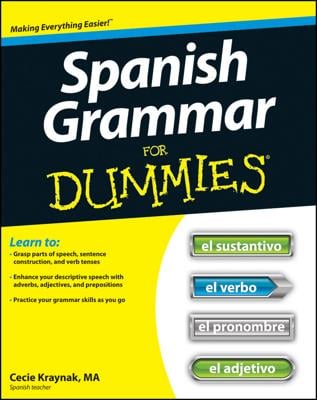Most Spanish verbs are predictable, especially in the present tense, which makes them fairly easy to master. The regular Spanish verbs come in three flavors — -ar, -er, and -ir — and conjugating them is easy. Regular verbs, therefore, are a great place to start your warm-up with the present tense.
Conjugating Spanish -ar verbs
Conjugating regular -ar verbs in the present tense is a snap. You take the infinitive form of the verb, which ends in -ar, chop off the -ar, and replace it with the ending for the appropriate subject pronouns: I, you, he, she, we, or they. The subject pronoun dictates the verb form that you use in a sentence. If you start a sentence with I, for example, and you use an -ar verb, that verb must end in -o.
The regular present tense -ar verb endings are as follows:
| Yo | -o |
| Tú | -as |
| él/ella/ello/uno | -a |
| Usted | -a |
| nosotros/nosotras | -amos |
| vosotros/vosotras | -áis |
| ellos/ellas | -an |
| ustedes | -an |
Conjugating Spanish -er verbs
The -ar verbs set the pattern for all the regular verbs, including the -er and -ir verbs. To conjugate -er verbs, you chop the -er off the end of the verb and add the appropriate verb endings so that the verb agrees with its subject. Here’s a handy table:
| Yo | -o |
| Tú | -es |
| él/ella/ello/uno | -e |
| Usted | -e |
| nosotros/nosotras | -emos |
| vosotros/vosotras | -eis |
| ellos/ellas | -en |
| ustedes | -en |
Conjugating Spanish -ir verbs
The -ar and -er verbs make up the bulk of the regular verbs, but a small number of -ir verbs round out the collection. You conjugate these verbs the same as the -er verbs, except for the nosotros and the vosotros forms:
| Yo | -o |
| Tú | -es |
| él/ella/ello/uno | -e |
| Usted | -e |
| nosotros/nosotras | -imos |
| vosotros/vosotras | -ís |
| ellos/ellas | -en |
| ustedes | -en |
Using the present tense in Spanish
A subject and a verb are all you really need to create a bona fide sentence: Yo canto (I sing). That’s a sentence. In Spanish, you can even drop the subject when its meaning is understood from the verb ending: Canto. Now that’s one short sentence. If you use two verbs together and the second one is in the infinitive form, you don’t need anything between them unless they’re a part of a verb structure, a commonly used phrase that contains one or more verbs.
The present tense in Spanish conveys not only an ongoing present tense action, such as “I’m talking on the phone,” but also an action that you’re in the habit of doing, such as “I talk on the phone a lot.” Adverbs help you make those distinctions. The tense is built right into the verb, but that isn’t always specific enough to describe precisely when an action is occurring in the present. Is it happening now, sometimes, always, every Saturday? By tacking on an adverb, you can express time more precisely.

